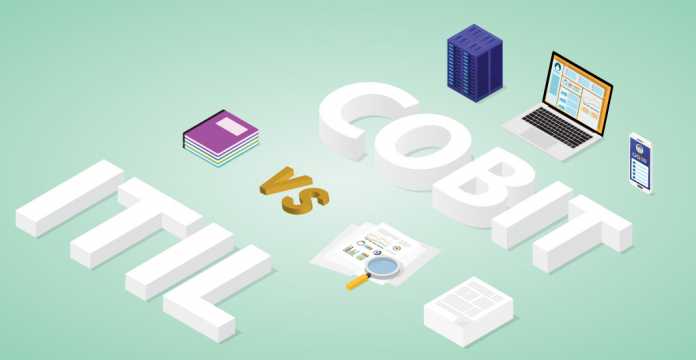
COBIT and ITIL are both IT Governance Frameworks that organizations use to increase the value of their business. COBIT stands for Control Objectives for Information and Related Technologies. ITIL stands for Information Technology Infrastructure Library. They are used to handle governance in IT Service Management (ITSM). Around 95% of companies use one of the major frameworks for their IT Governance, and more than 65% of them use more than one framework.
COBIT and ITIL both look at Information Technology (IT) in a company, but they do it differently. They can be used together to give better guidance when it comes to managing IT services.
Differences Between COBIT and ITIL
ITIL and COBIT 5 work together really well, but to do so, organizations need to know what exactly the difference between the two IT Governance frameworks is. ITIL enables all IT services to get managed, whereas COBIT acts as a supporting factor to governance so that businesses can get the most out of their IT investments while managing the risks.
COBIT
COBIT is used by companies to connect the outcomes of their IT strategy to the organization’s business outcomes. The COBIT framework gives companies all the resources such as the framework, descriptions of the process, guidelines for management, and so on to implement their IT strategies successfully and reduce costs and maintain standards at the same time. COBIT provides the required oversight to all existing IT processes.
The framework is based on meeting all stakeholders’ needs and creating value for them by managing risks, optimizing resources, and realizing all the benefits. COBIT covers all IT processes across the organization with one single integrated framework. It is a holistic framework consisting of different processes, cultures, ethics, organizational structures, infrastructure, and more. Using COBIT, companies can separate IT governance from management.
ITIL
ITIL is used to transform the regular Service Value Chain to generate actual value for the customer. The chain is weaved through the lifespan of ITIL through the traditional ITIL Service Lifecycle. It brings together all parts of the Service Lifecycle phase so that ITIL can create value for the consumers using different products and services. It enables collaboration through the four elements of ITIL, which are the Guiding Principles, Governance, Processes, and Continuous Improvement. This creates a standard output for companies that customers can experience and can be used to generate value.
ITIL vs COBIT
The main focus of COBIT is to govern all the IT processes in place in any organization. When it comes to ITIL, governance is only one part of generating value for stakeholders. COBIT and ITIL may seem similar when companies look at the frameworks at a glance, but the outcomes generated from each are different. With COBIT, the outcome is creating a network that provides end-to-end governance. When it comes to ITIL, it is focused on creating value for the business.
These frameworks should be used in organizations with a lot of mature processes in place because otherwise, there are chances that these complex practices will only confuse the employees and stakeholders. Both ITIL and COBIT have different sets of processes and roles, a lot of which overlap. The best way to manage this is to see which overlapping aspect provides the bigger benefit, and then go along with it. When it comes to supplier management or security, the preferred choice would be COBIT. But, when it comes to general management practices, service finance management, and talent management, for example, ITIL works better.
COBIT works better in parts and processes which require control, whereas ITIL works better for processes that require more collaboration with the stakeholders.
Scope of COBIT and ITIL
The importance of a successful IT Governance framework being implemented has been established by companies, which is why more and more companies have been adopting COBIT in their organizations. To improve the processes and make it more oriented to generate value, companies adopted ITIL alongside COBIT. The frameworks can easily be integrated and create a more holistic governance model for the company.
COBIT is used by companies to reduce their governance costs and also as a means to effectively manage risks and maintain privacy by creating a structure for all the ongoing IT processes in the company. This way, all business goals, and IT goals get connected.
COBIT can also be used to assign duties and fulfill objectives to different executives and team members in the company. The framework was made to integrate with other models for governance and oversight, such as ITIL, to utilize all resources and improve their implementation effectively.
When it comes to ITIL, it is used to cover ITSM Certification Courses specifically, rather than the integration of IT with the rest of the company like COBIT does. The way ITIL has been made makes room for implementation along with different other frameworks (such as COBIT) and other guidelines as well (such as Project Management Certification Courses, talent management, etc.). Companies use ITIL to improve the overall lifecycle of their product, starting from its inception to the point it reaches the customer.
COBIT and ITIL – Combined or Separate?
By understanding the features of COBIT and ITIL and how they are used in organizations, it becomes clear that when it comes to COBIT, it relates to answering a ‘what’ question when it comes to IT governance in a company and ITIL gives companies the answer to the ‘how’ in the improvement of processes.
Over time, research has revealed that both COBIT and ITIL complement each other, despite being designed by different organizations. Even though they may seem like they do not overlap and serve different purposes, they can be used together. COBIT helps identify what a company needs to do, and ITIL shows the company how it can be done in the best possible manner. This way, all IT resources get utilized to the maximum if implemented correctly.
Final Thoughts: Focus on Common Goals
COBIT and ITIL are both responsible for making sure that the IT resources invested in the company enable and improve all business operations. Both frameworks have a common goal and complement each other in achieving this goal for organizations. To make sure companies implement all the processes and strategies effectively, they need to train their employees thoroughly in the frameworks and procedures. The best way to successful implementation and integration is to do it with knowledge and expertise on the subject.
Some of the popular ITSM and ITSG certification courses that professionals can take up are:














